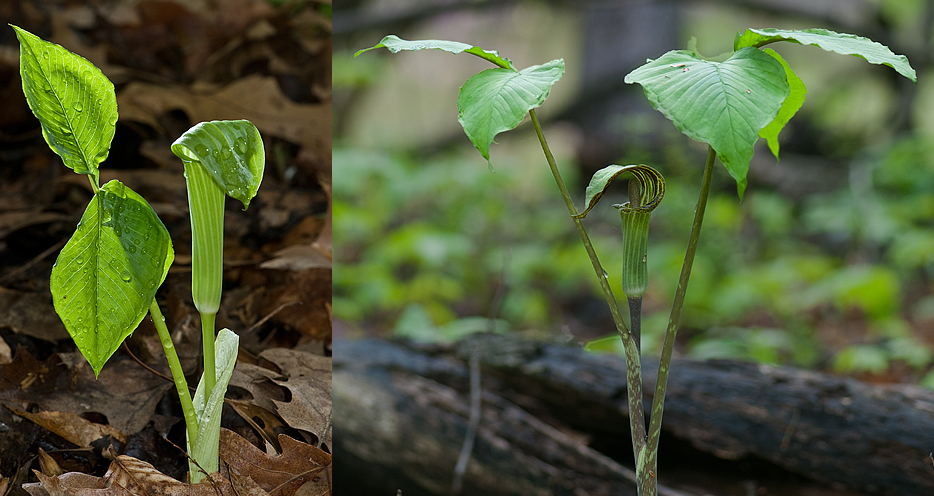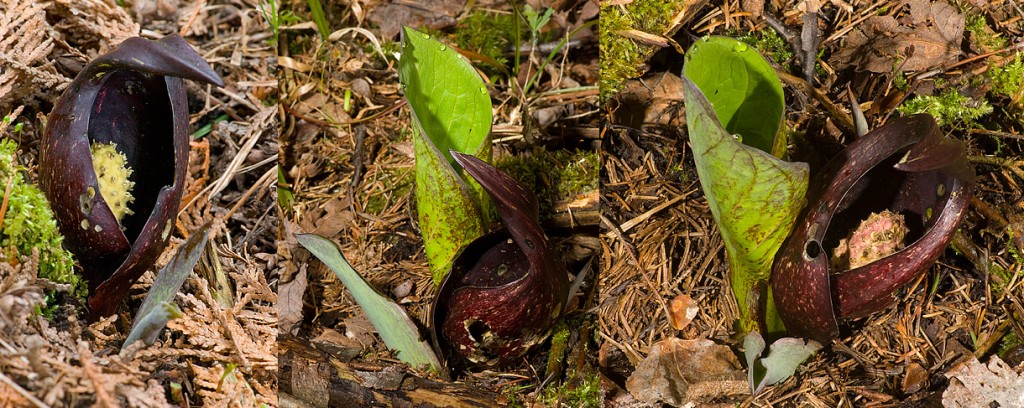Jack-in-the-pulpit (Arisaema triphyllum) is a common wildflower in Michigan, that blooms from early May into July. The largest plants are the latest to flower. The variability in the flower color, size, and blooming season produces in me a desire to recognize different species or subspecies in Michigan. It has been divided into species or subspecies south of Michigan by some botanists, but it does not seem possible to do so here. Environmental conditions or the ages of the plants cause many of the differences. Our largest plants, two-feet (.6m) high, grow at the edge of low areas in rich woods.
The plants are able to change sex from year to year. Young plants are male and typically have a single leaf. The female plants are larger and produce a pair of leaves. After a heavy seed set a plant sometimes reverts to male, then rebuilds its strength. When it is strong enough it will again become female.
The flower, actually an inflorescence, consists of two parts, an outer spathe (the pulpit) and an inner spadix (the Jack). The spathe is a modified leaf. The spadix has a cluster of small flowers called florets.
Skunk-cabbage (Symplocarpus foetidus) is one of the first flowers to bloom in the spring. I often find it flowering through the snow. It also has an inflorescence consisting of a spathe and a spadix. It grows in wet areas sometimes along a stream or at the edge of a marsh or swamp forest.
It is more common in Michigan south of Bay City. However, in the north it commonly occurs on islands. I have seen it on Thunder Bay Island and several places on Isle Royale. It is local on the mainland in northern Michigan, meaning that it does not occur in every suitable habitat. I know of several colonies along the North Branch of the Au Sable River near Grayling Michigan. The genus consists of a single species that grows in eastern North America and in northeast Asia.
The flowers have a distinctive odor that has been described as combining “the smell of skunk, putrid meat, and garlic.” It is not a powerful smell and I only notice it when I’m down close to the plants. The smell attracts flies and beetles that pollinate the flowers. The leaves produce a similar but stronger odor when crushed.
Skunk-cabbage flowers produce heat by a complex chemical process. If you desire more information, see Seymour et al. Skunk-cabbage maintains its flower temperature between 59 and 72 degrees F (15 to 22 degrees C). It does this when the air temperature is below freezing. The flowers thermoregulate so they do not become too warm. This is similar to warm blooded animals. We are not certain why this happens. It might provide a favorable habitat for pollinators or the flowers might require that temperature for fertilization to happen.
Skunk-cabbage is flowering now. Get out and look around for this interesting plant.
Works Cited
Seymour,M., Bryce, G., Christie, A., & Narashima, T. (1997,March). “Plants that Warm Themselves.” Scientific American 276: 104-109.
Copyright 2013 by Donald Drife
Webpage Michigan Nature Guy
Follow MichiganNatureGuy on Facebook



